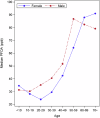Perfluorooctanoic acid serum concentrations and half-lives in a community exposed to contaminated drinking water in New York State
- PMID: 40247098
- PMCID: PMC12069094
- DOI: 10.1038/s41370-025-00769-z
Perfluorooctanoic acid serum concentrations and half-lives in a community exposed to contaminated drinking water in New York State
Abstract
Background: Investigations during 2014-2016 in two communities in New York State showed perfluorooctanoic acid (PFOA) in a public system serving 3800 residents (Hoosick Falls) averaging 534 ppt and in a smaller system serving 200 residents (Petersburgh) averaging 92.5 ppt. Bottled water (2015-2016) was provided until filtration brought PFOA levels to non-detectable (2016-2017).
Objective: The New York State Department of Health (NYSDOH) sought to address community questions about exposures and evaluate reductions in serum concentrations.
Methods: NYSDOH tested serum PFOA in 2016 just after drinking water exposure mitigation and again in 2018. Descriptive statistics for serum PFOA by sex, age, length of residence, and water consumption were evaluated using multiple regression, and half-lives were estimated.
Results: Using the serum PFOA GM and median for tests occurring within 3 months of exposure mitigation (N = 1121) (47.5, 54.2) produced serum to water ratios of 89.0 and 101.6. A total of 1573 Hoosick Falls public water consumers (337 <age 18) participated in 2016 baseline testing. PFOA GM was 42.1 mcg/L (ppb) (CI: 39.9-44.4), 27 times higher than the U.S. population, from NHANES, 2015-2016. Concentrations were significantly higher for males, older ages, longer residence, and higher water consumption in multivariate regression. Among children, concentrations were highest among the youngest, <3 years. Half-lives for 307 participants tested in 2016 and 2018 produced a GM half-life of 2.86, adjusted to the Hoosick Falls age distribution. GM half-lives increased with age, from 1.96 years (CI: 1.69-2.27) for youth under 18, to 3.55 years (CI: 3.27-3.87) for people over 60.
Impact: This biomonitoring project assisted communities with PFOA-contaminated drinking water by providing comparative exposure information and tracking body burden reductions to confirm exposures were minimized. These data are also critical for filling gaps in knowledge about PFOA modes of action and for the conduct of studies that can identify exposure concentrations associated with health risks. The detailed PFOA serum findings described here are being used to construct and validate pharmacokinetic models that will estimate exposures over the lifespan. These findings provide a foundation for PFOA exposure assessment that will benefit the national Multi-Site PFAS Health Study and future studies as well.
Keywords: Biomonitoring; Drinking water contamination; Half-life; Perfluorooctane sulfonate (PFOS); Perfluorooctanoic acid (PFOA).
© 2025. The Author(s).
Conflict of interest statement
Competing interests: The authors declare no competing interests. Ethics approval and consent to participate: The study was conducted as a public health service, a designation approved by the New York State Department of Health Institutional Review Board (IRB). As such, a formal IRB approval was not required. Adult participants were provided with detailed consent forms that offered options regarding storage of samples for additional analyses in the future. In addition, detailed protocols for the use of the 2015–2016 data for participants who recently enrolled in the CDC’s Multi-Site PFAS Health Study, currently underway, have been approved by the CDC IRB and by the New York State Department of Health IRB.
Figures
References
-
- ATSDR (Agency for Toxic Substances and Disease Registry). Toxicological Profile for Perfluoroalkyls. U.S. Department of Health and Human Services, Public Health Service. 2020. http://www.atsdr.cdc.gov/ToxProfiles/tp200.pdf.
MeSH terms
Substances
LinkOut - more resources
Full Text Sources
Medical


